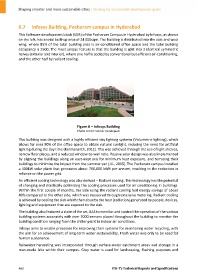Page 490 - Shaping smarter and more sustainable cities - Striving for sustainable development goals
P. 490
6.7 Infosys Building, Pocharam campus in Hyderabad
This Software development block (SDB) of the Pocharam Campus in Hyderabad by Infosys, as shown
on the left, has a total built‐up area of 24 000sqm. The building is distributed into the east and west
wing, where 85% of the total building area is air‐conditioned office space and the total building
occupancy is 2500. The most unique feature is that the building is split into 2 identical symmetric
halves (exterior and interior), where one half is cooled by conventional but efficient air‐conditioning,
and the other half by radiant cooling.
Figure 6 – Infosys Building
Photo credit: Sekhar Kondepudi
This building was designed with a highly efficient day lighting systems (Volumetric lighting), which
allows for over 90% of the office space to obtain natural sunlight, reducing the need for artificial
lighting during the day time (Kurmananth, 2012). This was achieved through the use of light shelves,
narrow floor places, and a reduced window‐to‐wall ratio. Passive solar design was also implemented
by aligning the buildings along an east‐west axis for minimum heat exposure, and terracing their
buildings to minimize the impact from the summer sun (JLL, 2015). The Pocharam campus installed
a 400kW solar plant that generates about 700,000 kWh per annum, resulting in the reduction in
reliance on the power grid.
An efficient cooling technology was also derived – Radiant cooling. This technology has the potential
of changing and drastically optimizing the cooling processes used for air conditioning in buildings.
Within the first couple of months, the side using the radiant cooling had energy savings of about
40% compared to the other side, which was measured through extensive metering. Radiant cooling
is achieved by cooling the slab which then absorbs the heat (radiation) generated by people, devices,
lighting and equipment that are exposed to the slab.
The building also featured a state of the art, BAS to monitor and control the operation of the various
building systems accurately with over 3000 sensors placed throughout the building to monitor the
building condition ranging from the chiller plant to indoor air conditions.
Infosys aims to enable processes for improving their systems for monitoring water recycling, with
the aim for an achievement of long‐term water sustainability. Fresh water was only to be used for
human sustenance.
Rainwater harvesting was incorporated through surface‐water catchment areas and storage in a
man‐made lake within their campus. Grey water is used for landscaping, flushing purposes and
480 ITU‐T's Technical Reports and Specifications

